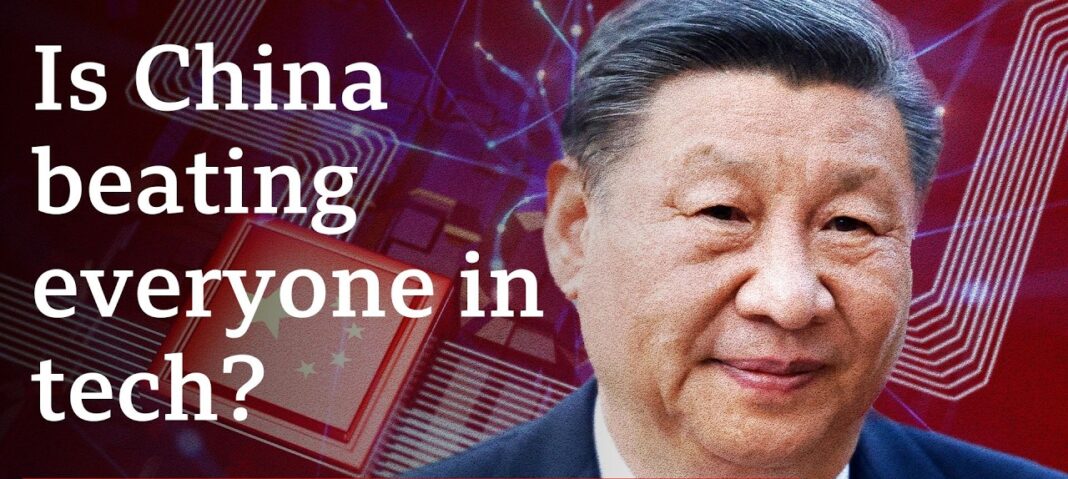China’s rapid advancements in artificial intelligence (AI), electric vehicles, renewable energy, and other cutting-edge technologies have positioned it as a formidable competitor to the West. The emergence of AI chatbots like DeepSeek, the global dominance of Chinese social apps such as TikTok and Shein, and leadership in electric vehicle (EV) production highlight China’s growing influence in tech industries.
This article examines China’s technological rise, the strategies behind its success, its ongoing challenges, and the implications for global markets, businesses, and governments.
The Rise of Chinese Tech Giants
China’s technological growth is not limited to AI. The country has also become a leader in several high-tech industries, including:
1. Artificial Intelligence (AI)
- China has overtaken the U.S. in AI patent filings.
- AI chatbots like DeepSeek are gaining global recognition, competing with U.S. tech giants.
- Government-backed AI research centers are driving advancements in machine learning, automation, and robotics.
2. Electric Vehicles and Battery Production
- China is the world’s largest EV market, with companies like BYD surpassing Tesla in sales.
- It leads in battery manufacturing, supplying 80-95% of the global EV battery market.
- By 2028, 60% of the world’s renewable energy is expected to be generated in China.
3. Social Media and E-commerce Domination
- Apps like TikTok, Shein, Temu, and CatCat are disrupting global markets.
- TikTok became the first non-U.S. social network to gain widespread Western adoption.
- Chinese e-commerce models focus on low-cost goods, rapid supply chains, and AI-driven personalization.
4. Drones and Quantum Computing
- China produces 70% of the world’s drones, with DJI dominating the global market.
- Chinese researchers publish more quantum computing research papers than any other nation.
- China is competing with the U.S. for quantum supremacy, an area critical for cybersecurity and defense.
The Made in China 2025 Strategy: A Blueprint for Dominance
The foundation for China’s tech expansion was Made in China 2025, an ambitious government initiative launched in 2015 to transition from low-cost manufacturing to high-tech innovation.
The strategy outlined 10 key sectors for investment, including:
- AI and automation
- Electric vehicles and clean energy
- Quantum computing and semiconductors
- Aerospace and advanced robotics
According to an analysis by the South China Morning Post, 86% of the goals set in Made in China 2025 have already been achieved, surpassing expectations in EVs, renewable energy, and AI development.
How China Achieved Its Tech Dominance
China’s success is largely attributed to a state-backed capitalism model, which includes:
- Massive government funding: The Chinese government has allocated $1.5 trillion to research, development, and foreign acquisitions.
- Joint ventures and knowledge transfer: Foreign firms entering China often have to share their technology with local partners.
- Talent acquisition: China has aggressively recruited top engineers and scientists through financial incentives and global collaborations.
Additionally, some Western governments have accused China of technology appropriation through state-backed acquisitions and industrial espionage, fueling tensions in the U.S.-China trade war.
Areas Where China Still Lags Behind
Despite its progress, China faces several challenges in its tech ambitions:
1. Semiconductors and Chip Manufacturing
- China lags behind the U.S., Taiwan, and South Korea in advanced semiconductor production.
- U.S.-led sanctions have restricted China’s access to high-end chips, further delaying its progress.
2. Western Trade Barriers and Sanctions
- The U.S. and allies have introduced export controls and investment restrictions to curb China’s rise in AI and semiconductor development.
- Countries like Germany and Japan have launched their own counter-strategies to limit China’s tech expansion.
3. Regulatory Risks for Chinese Tech Firms
- Apps like TikTok face bans and legal scrutiny in the U.S. and other Western nations due to data privacy and national security concerns.
- The Chinese government’s crackdown on its own tech giants has slowed innovation in some areas, particularly in fintech and online services.
The U.S. and Western Response: Can They Keep Up?
Recognizing the strategic threat posed by China’s tech leadership, the U.S. and its allies are making aggressive counter-moves:
- $500 billion U.S. investment in AI infrastructure (announced in 2024) to compete with China’s advancements.
- Increased funding for semiconductor manufacturing through the CHIPS Act, aimed at boosting domestic chip production.
- Strengthened alliances with Japan, South Korea, and the EU to create a non-China-dependent tech supply chain.
The U.S. still holds an advantage in semiconductors, enterprise AI, and software innovation, but China’s rapid acceleration poses long-term economic and geopolitical risks.
Future Outlook: What Comes Next?
China’s tech dominance is expanding, but it still faces hurdles in semiconductors, regulatory challenges, and trade restrictions. The global race for tech supremacy is far from over, and the next decade will determine:
- Will China overtake the U.S. in AI and quantum computing?
- Can the U.S. maintain its semiconductor leadership despite China’s efforts?
- How will geopolitical tensions affect tech trade and global supply chains?
Key Takeaways:
- China leads in AI, EVs, renewable energy, and drones, fueled by Made in China 2025.
- State-backed capitalism and government funding have propelled its rise, but trade restrictions are slowing progress in semiconductors.
- The U.S. and its allies are ramping up investments to counter China’s influence in high-tech industries.
- Global competition in AI, quantum computing, and clean energy will shape the next decade of technological leadership.
Future Considerations:
- For Businesses: Companies must assess supply chain risks and opportunities amid U.S.-China tensions.
- For Governments: Stronger alliances and investment in emerging technologies will be critical.
- For Consumers: Expect increasing regulations on Chinese tech products, impacting social media, e-commerce, and electronics.
Disclaimer
This article is based on publicly available information and expert analysis. It does not constitute financial, political, or investment advice. Readers should conduct their own research before making business or policy decisions.
Dr. Ethan Ramirez is a leading AI strategist with 12+ years of experience in developing AI solutions for Fortune 500 companies. He holds a PhD in Machine Learning and regularly speaks at global AI conferences.




